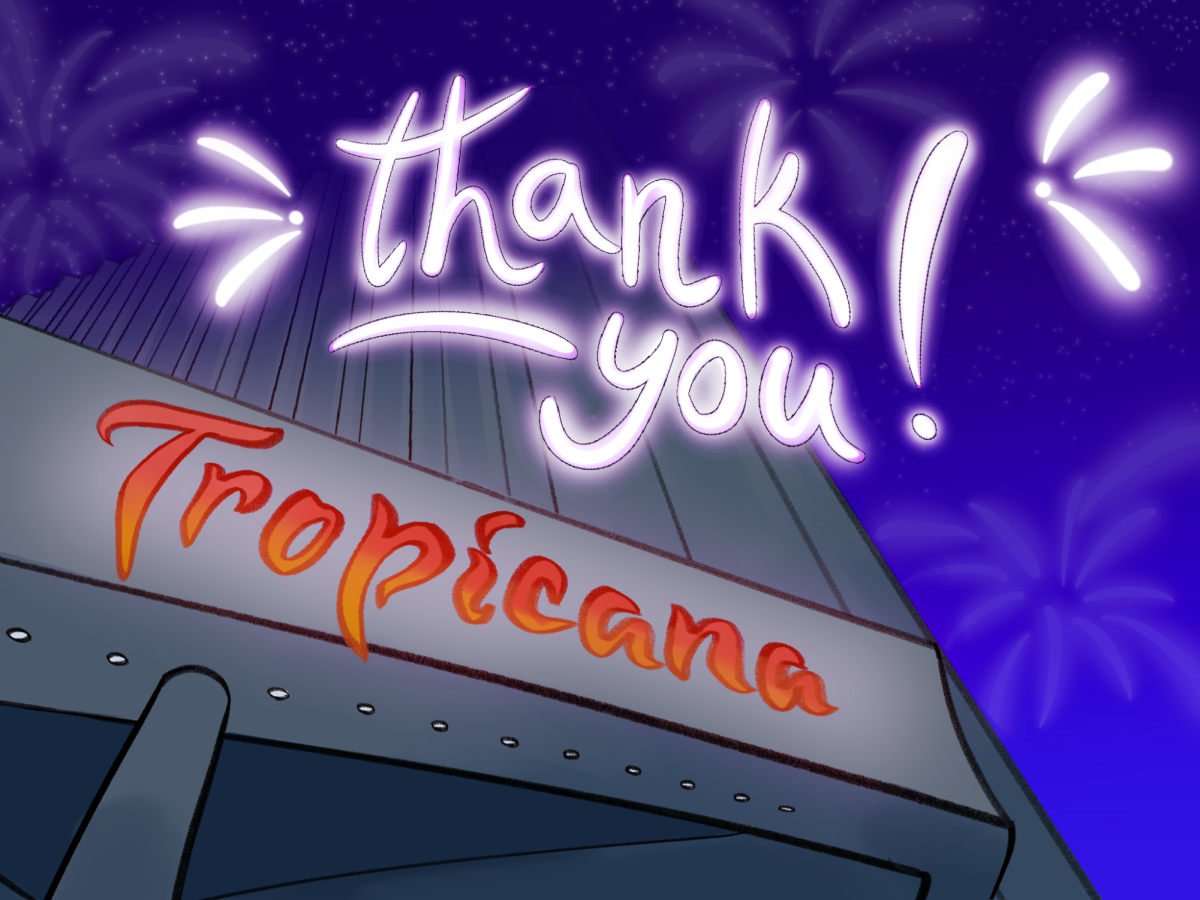The Tropicana Hotel ended its 67 year-long legacy with a boom on October 9, then a crash. In classic Vegas fashion, Controlled Demolition Inc. hosted an elaborate fireworks display to celebrate the ending of the Tropicana legacy. Images lit up the sky with heartfelt goodbye messages, and neon drones showcased an impressive 3D countdown. The display was a homage to the Tropicana Hotel, which opened April 4, 1957 as one of the first grand casinos to enter Las Vegas. It was nicknamed “Tiffany of The Strip” for its luxurious themes, glamorous showgirls, and guests like Louis Armstrong.
However, this Sin City sendoff, while a great show, shouldn’t divert attention from Las Vegas’ growing issues. The installation of brighter and bolder attractions has been a concerning threat to long-time residents. The recent construction of attractions like the giant Sphere simultaneously disoriented and amazed tourists and locals alike, shedding light on the growing modernization of The Strip. In the case of the Tropicana Hotel, the city plans to establish a $1.5 billion baseball stadium for the Oakland Athletics.
“I mean, the Tropicana was one of the first few casinos in Las Vegas, alongside the Flamingo, and I feel like that’s a part of our history,” senior Tavin Secrist said. “Yeah, it’s kind of cool that we’re getting our own sports team, but with the Raiders, they’re not that great. The Raiders have not been doing so well ever since they moved from Oakland, and I’m not sure what’s going to happen with the new team that’s coming.”
Despite the heavy history that comes with Vegas’ construction in the early 1900s, Las Vegas’ economy relies heavily on the tourism industry. As such, appealing to a larger group of tourists requires the constant destruction and renovation of areas like The Strip.
“I see them continuing to try to strive to bring in things that attract tourists, including things like the F1,” Environmental Science teacher Martha Horner said. “We are a tourist destination, and everything is centered on that tourism around The Strip. So in future aspects, I’d see them developing that Strip area and spending a ton of money to continue to bring tourists and dollars into the region.”
Research on visitor spending by Las Vegas Convention and Visitors Authority (LVCVA) showed that “The total economic output related to visitor spending in 2022 (including direct, indirect and induced impacts) reached an all-time high of $79.3 billion, equivalent to about half of the region’s gross economic output.”
“It stinks because, realistically, I understand how this town works. It’s always like, the newer, the better, the best,” Social Studies teacher Jessica Kelly said. “We’re not necessarily a very historical preservation type of town—[and] I’m a history teacher—so I would prefer that we were. But we do get things like the neon sign, and that will still be preserved, [along with other] things that we can reflect back on.”
Three months following the Tropicana Hotel’s closing on April 2, 2024, The Mirage was met with a similar fate, closing on July 17 that same year. The Mirage had a legacy similar to the Tropicana Hotel. It was renowned for being the world’s largest hotel upon opening, praised for its iconic volcano attraction, and applauded for its illustrious entertainment. But after 35 years of service, Las Vegas has set its sights on expanding one of its existing properties: Hard Rock Hotel.
“It wasn’t good in its latter years, like it [The Mirage] was already failing as a casino and as a hotel,” junior Hayley Hines said. “After COVID, everything was just terrible. So it was probably good that it closed down because the workers weren’t being treated well. And my grandma actually ended up quitting. She got a payout right before they closed, and they were paying out employees to leave.”
As each attraction outshines the last, The Strip aims to build the Hard Rock Hotel and Casino as a 700-foot tall guitar. The plan imitates the recent trends in The Strip’s buildings, such as The Sphere.
“I think they lack a lot of character,” Hines said. “Like Resorts World and stuff, they’re all trying to bring that. They’re trying to bring back that old Vegas luxury, but they just can’t bring back old Vegas luxury. It’s gone. It’s a bygone era. The city is always moving forward.”
While The Strip is widely considered the heart of Las Vegas, there are other popular sites that remain well-preserved. Fremont Street is the oldest street from 1905, home to the first casino, traffic light, and telephone line. However, Fremont Street has also had its fair share of renovations as the city aims to grow in popularity.
“We’re in a valley. There is a limited amount of land and space for where they want the tourists to be, and The Strip is the number one area for tourists,” Horner said. ”So things like the implosion of casinos, replacing it with something else, in a lot of ways, it makes sense. Because you want it [casinos, hotels] in that tourist area, you want it where there’s ease of lodging, the ease of access to food, where you can get to all of that easily. So I really don’t see anything on the strip itself as being historical. I mean, if we were talking about down in old Vegas near Fremont Street and everything, I could see those maybe being a little bit more historical than something that’s on The Strip, which is geared toward tourists. But if we don’t keep tourists coming into the city, then it destroys our economy.”
According to The Nevada Independent, Las Vegas boomed with over 40.8 Million visitors in 2023, which is a 5.2% increase from the previous year. While this is a positive sign for the economy, it brings attention to the other issues in the city. Vegas is struggling for space, and expanding outwards is no easy task.
“My biggest concern is that we are growing,” Horner said. “And we don’t have truly enough resources in regards to land and infrastructure to support a population, or a larger population than what we already have. We live in a desert where water is an issue, and so I would hope that we would begin the growth of the overall city itself, [and that it] would stabilize, because we really don’t have the resources to support a population.”


![Swaying and preparing to toss the tennis ball, Dylan Grove practices serving. Grove had been training in preparation for her upcoming matches against Chaparral and Doral Red Rock. “[Both teams are] both very tough opponents, but I am ready for whatever gets thrown my way,” Grove said.](https://southwestshadow.com/wp-content/uploads/2025/10/image-1200x900.png)




